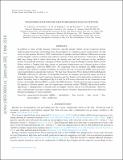Files in this item
Transverse wave induced Kelvin-Helmholtz rolls in spicules
Item metadata
| dc.contributor.author | Antolin, Patrick | |
| dc.contributor.author | Schmit, Don | |
| dc.contributor.author | Pereira, Tiago M. D. | |
| dc.contributor.author | De Pontieu, Bart | |
| dc.contributor.author | De Moortel, Ineke | |
| dc.date.accessioned | 2018-03-08T15:30:06Z | |
| dc.date.available | 2018-03-08T15:30:06Z | |
| dc.date.issued | 2018-03-23 | |
| dc.identifier | 252493078 | |
| dc.identifier | 81af849b-1b91-48d9-97de-928511b9750b | |
| dc.identifier | 85044764086 | |
| dc.identifier | 000428306500001 | |
| dc.identifier.citation | Antolin , P , Schmit , D , Pereira , T M D , De Pontieu , B & De Moortel , I 2018 , ' Transverse wave induced Kelvin-Helmholtz rolls in spicules ' , Astrophysical Journal , vol. 856 , no. 1 , 44 . https://doi.org/10.3847/1538-4357/aab34f | en |
| dc.identifier.issn | 0004-637X | |
| dc.identifier.other | BibCode: 2018arXiv180300821A | |
| dc.identifier.other | ORCID: /0000-0002-1452-9330/work/43387945 | |
| dc.identifier.uri | https://hdl.handle.net/10023/12880 | |
| dc.description | This research has received funding from the UK Science and Technology Facilities Council (Consolidated Grant ST/K000950/1) and the European Union Horizon 2020 research and innovation programme (grant agreement No. 647214). | en |
| dc.description.abstract | In addition to their jet-like dynamic behaviour, spicules usually exhibit strong transverse speeds, multi-stranded structure and heating from chromospheric to transition region temperatures. In this work we first analyse Hinode & IRIS observations of spicules and find different behaviours in terms of their Doppler velocity evolution and collective motion of their sub-structure. Some have a Doppler shift sign change that is rather fixed along the spicule axis, and lack coherence in the oscillatory motion of strand-like structure, matching rotation models or long wavelength torsional Alfvén waves. Others exhibit a Doppler shift sign change at maximum displacement and coherent motion of their strands, suggesting a collective MHD wave. By comparing with an idealised 3D MHD simulation combined with radiative transfer modelling, we analyse the role of transverse MHD waves and associated instabilities in spicule-like features. We find that Transverse Wave Induced Kelvin-Helmholtz (TWIKH) rolls lead to coherence of strand-like structure in imaging and spectral maps, as seen in some observations. The rapid transverse dynamics and the density and temperature gradients at the spicule boundary lead to ring-shaped Mg II k and Ca II H source functions in the transverse cross-section, potentially allowing IRIS to capture the KHI dynamics. Twists and currents propagate along the spicule at Alfvénic speeds, and the temperature variations within TWIKH rolls produce sudden appearance/disappearance of strands seen in Doppler velocity and in Ca II H intensity. However, only a mild intensity increase in higher temperature lines is obtained, suggesting there is an additional heating mechanism at work in spicules. | |
| dc.format.extent | 1399537 | |
| dc.language.iso | eng | |
| dc.relation.ispartof | Astrophysical Journal | en |
| dc.subject | Magnetohydrodynamics (MHD) | en |
| dc.subject | Instabilities | en |
| dc.subject | Sun: activity | en |
| dc.subject | Sun: corona | en |
| dc.subject | Sun: chromosphere | en |
| dc.subject | Sun: oscillations | en |
| dc.subject | QB Astronomy | en |
| dc.subject | QC Physics | en |
| dc.subject | NDAS | en |
| dc.subject.lcc | QB | en |
| dc.subject.lcc | QC | en |
| dc.title | Transverse wave induced Kelvin-Helmholtz rolls in spicules | en |
| dc.type | Journal article | en |
| dc.contributor.sponsor | Science & Technology Facilities Council | en |
| dc.contributor.sponsor | Science & Technology Facilities Council | en |
| dc.contributor.sponsor | European Research Council | en |
| dc.contributor.institution | University of St Andrews. Applied Mathematics | en |
| dc.contributor.institution | University of St Andrews. School of Mathematics and Statistics | en |
| dc.identifier.doi | 10.3847/1538-4357/aab34f | |
| dc.description.status | Peer reviewed | en |
| dc.identifier.url | http://adsabs.harvard.edu/abs/2018arXiv180300821A | en |
| dc.identifier.grantnumber | ST/N000609/1 | en |
| dc.identifier.grantnumber | ST/K000950/1 | en |
| dc.identifier.grantnumber | 647214 | en |
This item appears in the following Collection(s)
Items in the St Andrews Research Repository are protected by copyright, with all rights reserved, unless otherwise indicated.

